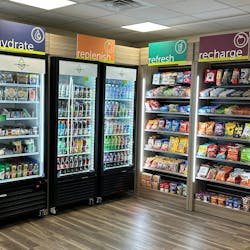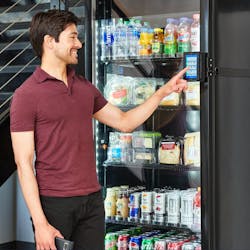Big data is proof that you must indeed be careful what you wish for. With technology integration comes an onslaught of confusing information. On one hand, vending operators utilizing most of what today’s industry technology has to offer can see every aspect of their business. A vending machine becomes a dynamic automatic retailer that via MDB, DEX and telemetry offers data about equipment status, payment acceptor jams, item level product sales, cash in, sellouts and service.
On the other hand, big data doesn’t stop there. Micro markets provide invaluable data of their own. Suppliers have specific systems that report on products sales, customer preferences, loyalty programs and more. Coffee service data contributes either as part of the vending management system (VMS) or sometimes on its own.
Outside the industry-specific systems, savvy operators are also looking at online data — visits to their Website, social media interaction, SEO (search engine optimization), consumer trends and a lot of non-structured data that all melds together to give operators an idea of how their businesses are ranking in the local area and with customers.
That is big data, the tsunami of information that the industry can now gather. For most it’s overwhelming, and equally staggering to turn that data into action.
The good news is that big data is a revolutionary force that allows operators to maximize their opportunities. Although it is a difficult force to tame, here are five tips from successful operators who are working to harness vending’s big data.
Focus on key metrics daily
First, look at how and where you are getting the data. Focus on some important metrics to start.
“We use remote machine monitoring [telemetry] on machines to collect data for sales, inventory and machine errors,” said Jeffery Smith, President and CEO of All Star Services, Inc. based in Port Huron, MI. He reviews this information daily. “The data can be very overwhelming,” he said. Despite this, Smith understands that data can help him improve his level of service to the customer and operational efficiencies as a company. “We like to use the data not just to identify issues and set corrective action, but also to answer questions about the business.”
In addition to capturing the data, Smith has created an internal process where changes based on the analysis can be done very quickly, often the next day. “This is very key as we can see items of interest that sales have increased and it would allow us to make a conscious decision to add facings of a specific item to ensure sufficient inventory on site,” said Smith.
Break it down to now, and later
Operators are capturing a lot of different forms of data, often more than they can analyze initially. It’s important to capture data and implement a long and short term analysis strategy.
“Today we’re collecting SKU turn data (vending), UPC turn data (micro markets) cash sales, cashless sales, connectivity reports, user frequency, emails and even cell numbers,” said Jeff Whitacre, CEO of Food Express located in Greensboro, N.C. and founder of USConnect. Whitacre considers the data streams invaluable in running his business profitably. He focuses on which machines to service when and what products to offer, thanks to his VMS. At the same time, he outsources the user data collection. It’s important to him, but something he can’t dedicate his resources to right now. “We are still figuring out how to assimilate it all into useful streams, but I’m happy with what we’re collecting today and look forward to expanding into more complex user data,” Whitacre said.
Make sure you understand the VMS
One of the challenges operators must overcome in the big data world is finding the right system and the right person to dedicate to technology. Bill Meckstroth, co-owner of Midwest Refreshments in Dayton, OH, knows firsthand how difficult it can be if you don’t speak the language. “Telemetry systems are very costly,” said Meckstroth. Getting some onsite training to go with a telemetry system adds more to the cost, but is important. “I’m not an IT guy,” said Meckstroth. “I can’t talk their language. They need to speak our language to be successful.”
Meckstroth went through a number of telemetry systems looking for the one that best fit his needs of clear understanding and service. Right now he uses ParLevel’s cloud-based VMS. “Cloud-based is the only way to go,” he said. It allows him to call up reports and real-time service logs from any computer or mobile device, including when he’s presenting a proposal to a location.
Meckstroth sees the need for an employee with technical expertise as very strong and getting stronger. One reason is the firmware upgrades done by manufacturers. “It’s my belief that in the next 5 to 7 years, every vending company that wants to succeed with technology will have to bring on board an IT person or contract a third-party IT company,” explained Meckstroth.
Operations and prekitting are key
Telemetry often pays for itself through improvements in product inventory, sales and scheduling. Using the sales data it provides to merchandise the vending machine provides returns over and above the investment.
“The way I sleep at night is that the data is just an extra add-on benefit,” said Scott Meskin, president of Black Tie Services Inc. in Baltimore, MD. When he opted to add telemetry, he focused on the company’s ability to dynamically schedule, prepack with a 99 percent accuracy and to know exactly how much money was in the vending machine when it was serviced. Then he was able to control inventory on his delivery vehicles and the SKUs in the warehouse. “To get the ROI, you don’t have to use the product sales data,” said Meskin. “But if you do use the data, you will get even more.”
One difficulty Meskin has found is in identifying and acting on data. “There is always data coming in. The challenge is not only noticing what has to be done, but also sending people out to make it happen,” he said. In some VMSs, swapping one product for another across all locations, a global change, can be difficult and time consuming. Vending machines are often individualized allowing unique planograms, but this means going into each machine in the VMS to change the product. “That can be hundreds of machines,” said Meskin.
To make a global change, Meskin has the new product added to the pick line. It’s prekitted and the driver is told what product the new one is replacing. The driver will place the new product behind any old product left in the spiral. For a few weeks, Meskin will have to call up sales of the new product under the old name until all the machines are changed out in the VMS. “It takes a while to do,” he added.
For micro markets the data comes with the systems. Meskin looks at micro market sales data mostly to identify potential marketing promotional opportunities for locations. For example, if 200 people buy a cup of coffee at a location, Meskin might try to identify an item he can bundle with the coffee to encourage incremental sales. “The same with sandwiches...I’ll bundle a sandwich, chips and a soda to encourage the customer to make a bigger purchase,” he said.
Measure results and look for opportunities
For Sandy Thornton, co-owner of VendEdge in Ringgold, GA, it was obvious from day one that the investment in technology was paying off. “Our route cost decreased significantly with the implementation of remote monitoring,” she said. In the warehouse, a pick-to-light system increased the efficiencies right away. “It is important to maintain or increase route collection averages, have a low out of stock ratio and keep an ear toward our employees to listen for issues that they encounter or suggestions that they make for improvement. These can then be verified through data we have collected,” explained Thornton. After the efficiencies and collection averages, Thornton set about looking at analytics. The data allowed the company to rework planograms and uncovered areas where it was necessary to change the tray configurations in the snack machines as well as the spiral counts.
Thornton looks at daily sales reports along with maintenance logs and the route compliance logs (which reflects if the driver serviced every machine that was assigned for the day, what time it was done and how much the collections should be as well as the actual amount collected). She believes strongly that good data is paramount to getting the most out of analytics. “The info that comes into the system from drivers using their tablets is critical to maintain correct inventories in the field. If that process slips, the data is corrupted and becomes much less valuable. The same is true for purchases being entered into the system consistently and correctly,” said Thornton.
Another piece to the maintaining good data is ensuring the Celluar/DSL connections. “The remote vending devices rely on a cellular connection to transmit the DEX info to the VMS. Without good cellular signals at each machine, we have installed Hi Gain antennas to overcome most of those issues. As for the DSL lines, those are our live connections to the markets.”
Data is a powerful tool. It gives an operator facts, not impressions, about what sells and when. It saves time, energy and money when used wisely with good, usable data, solid cellular/DSL connections and regular review.





